Wat Rong Khun Temple is a famous Buddhist complex in Thailand. It is known for being executed almost completely in boiling white color of the most chalky shades, delicately decorated with mosaics with mirror splashes, furnished with an abundance of thematic sculptures. The White Temple is a popular place to visit. It features artfully decorated scenes with the participation of mythological characters, and the eye is attracted by numerous details, expertly executed in alabaster.
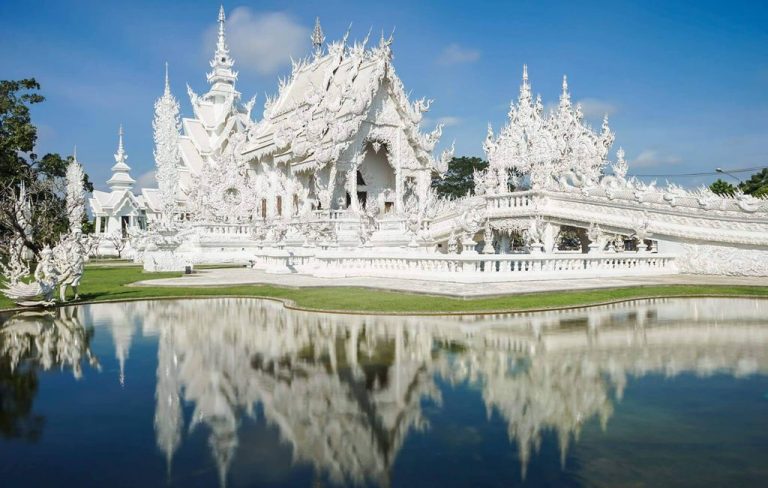
Despite the fact that the architecture and interior of the temple are practically devoid of any painted elements, in the rays of the morning and evening dawn the room is filled with paints of various shades. Masses of visitors rush to him to join in the amazing, real, man-made beauty. Everyone who visited the Rong Khun temple tells about what they saw as futuristic paintings, where each fresco, figure, sculpture or pattern is endowed with a specific, own meaning.
Construction history
The white temple in Thailand appeared in 1997 on the site of an almost collapsed Buddhist sanctuary, and its construction continues today. The reasons for such a long erection and arrangement are associated with the painstaking work of creating creative masterpieces, and with the earthquake that happened in 2014. As a result of the damage, it was decided not to restore the building, but later the expediency of the restoration work was confirmed, and the temple of Wat Rong Khun is still being updated and recreated.
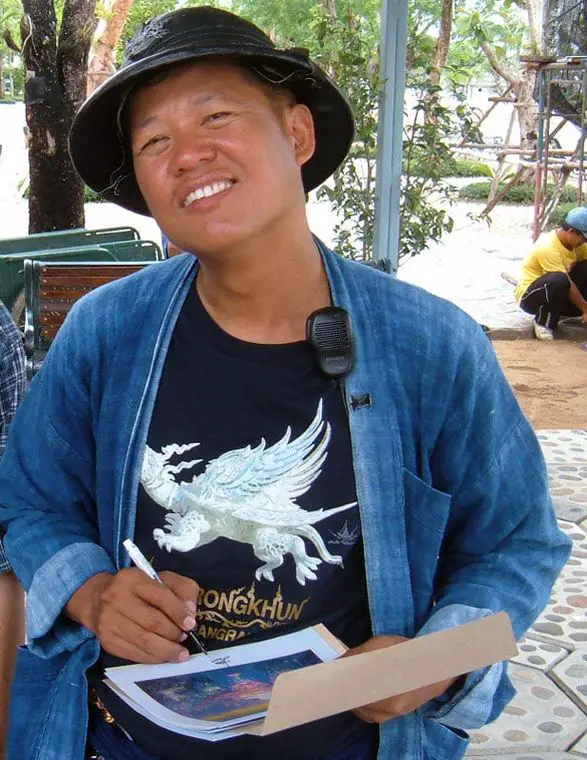
The complex owes its appearance to the artist Chalermchay Kasitpipat – it is he who acts as the author and almost the only performer of clever ideas and artistic incarnations. The white base of the temple buildings is a symbol of the purity of the Buddha and the embodiment of nirvana, a myriad of small mirrors – divine wisdom embodied on earth. And the artist’s idea in sculptural compositions touches on the eternal theme of the confrontation between good and evil forces both in the outside world and in human nature. In total, nine temple buildings were conceived. The ideological inspirer of the White Temple in Thailand claims that the construction was planned for 90 years and will be completed by the students and followers of the architect.
When visiting, it is proposed to purchase souvenirs and paintings by the artist Chalermchay Kasitpipat. It is noteworthy that the author invests all means from the sale of his works in the construction, resolutely rejecting anyone’s participation or help. So the architect preserves the independence of his inspiration and imagination.

Work to ensure the temple complex is truly ambitious, ranging from detailed design, directly to construction and ending with the creation of interiors, murals, and the establishment of infrastructure. It is believed that over two decades of the project’s existence, large sums with six zeros have already been invested in it.
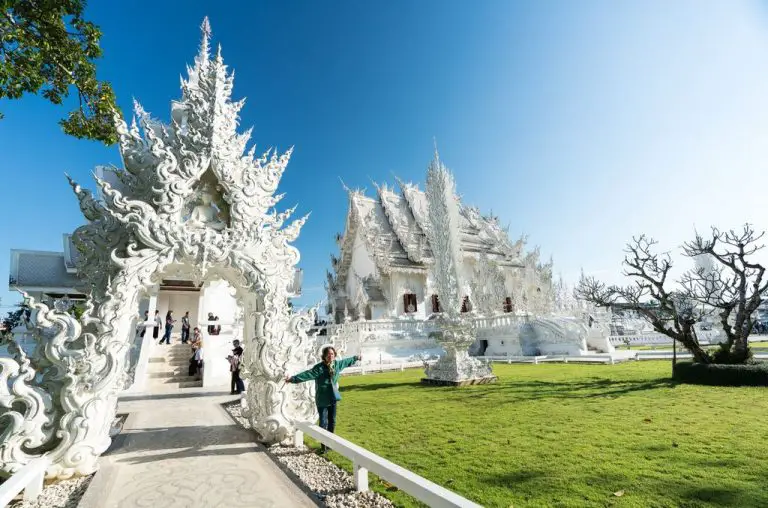
According to the global author’s idea, the temple of Wat Rong Khun in Thailand should turn into a large Buddhist center in which numerous comers can learn sacred knowledge. Thanks to a new reading and interpretation of traditional canons, modern religious ideas are called upon to become more accessible to understanding by the masses who are looking for answers to their questions. Therefore, in the architectural complex there are so many unexpected design decisions that catch the eye and make you rethink some of the established dogmas. Maybe that’s why the artist Chalermchay Kasitpipat is called modern Salvador Dali.
Architecture and Interior
This temple in Thailand is not computer graphics, as it may seem to an inexperienced person when looking at photos of the sights from the monitor screen. It exists, and you can spend hours looking at the subtleties and details of the decoration, comprehending the artist’s intention or speculating on the meaning of the individual elements.
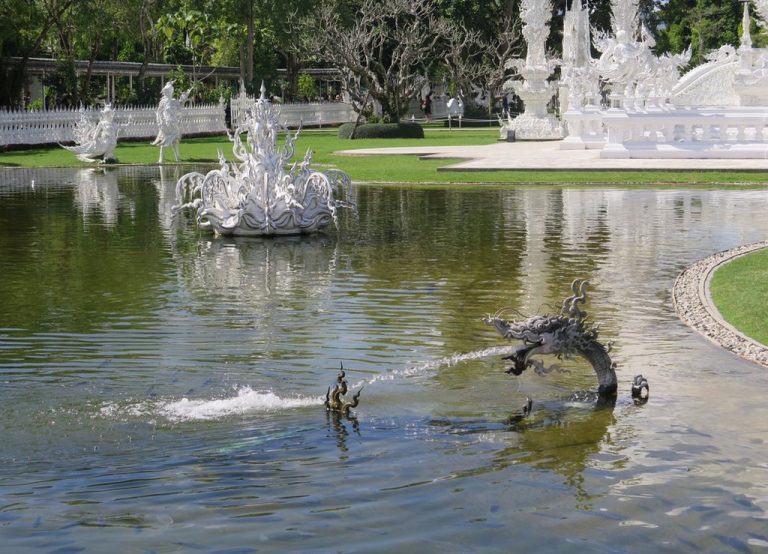
The White Temple is the focus of subtle taste and noble worldview embodied in architecture. Bizarre patterns, shapes and lines, sculptural compositions, fountains, a combination of the ancient foundations of Buddhism with a progressive outlook on life – everything here is permeated by the creator’s desire to convey the main thing to human consciousness.
There are also pleasant to the eye, friendly sculpture, and frankly sinister! And a blindingly attractive snow-white temple, upon closer inspection, may turn out to be frightening in some details, but no less interesting to study. The roof of the White Temple of Wat Rong Khun is crowned with the attributes of four elements that are fundamental in Buddhism. These are earth, air, water and fire, respectively – an elephant, a swan, a snake and a lion.
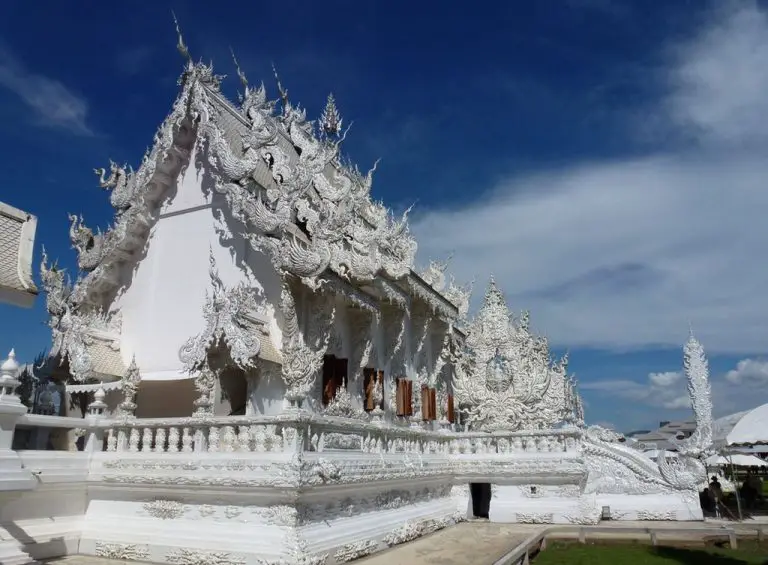
Currently, three buildings have been erected: the White Temple, the gallery and the Golden Palace. In the future, it is planned that they will be added to:
- chapel;
- monastery;
- pavilion;
- Museum
- pagoda;
- room for sermons;
- restroom.
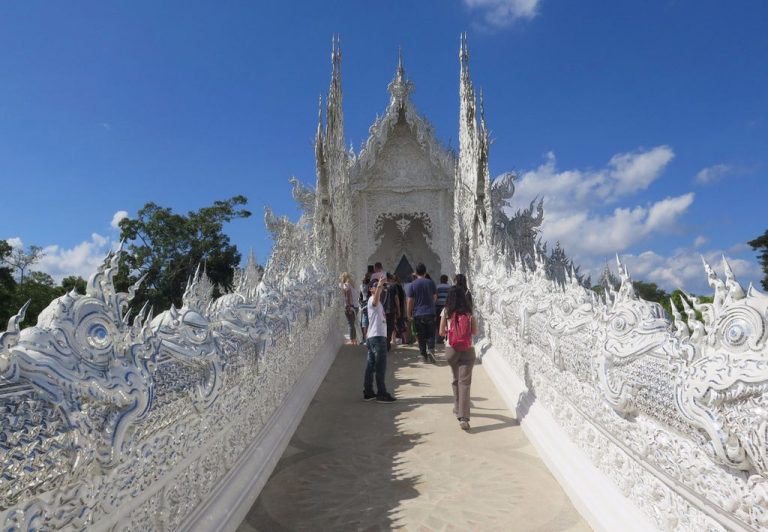
The path to the temple runs through the openwork bridge, which identifies the movement from life’s problems to the world of eternal bliss. At the base of the bridge, a circle is marked, from where huge fang-like outgrowths of the teeth of a fabulous creature that can absorb stars and planets ascend to heaven. On the way to the White Temple, an unexpected sight opens up – human hands growing directly from under the ground. This is a symbolic hellish place, reminiscent of the fact that you need to take care of the salvation of your soul in a timely manner, so as not to become the same sinner, asking for alms of grace and forgiveness, having already been condemned to eternal torment.
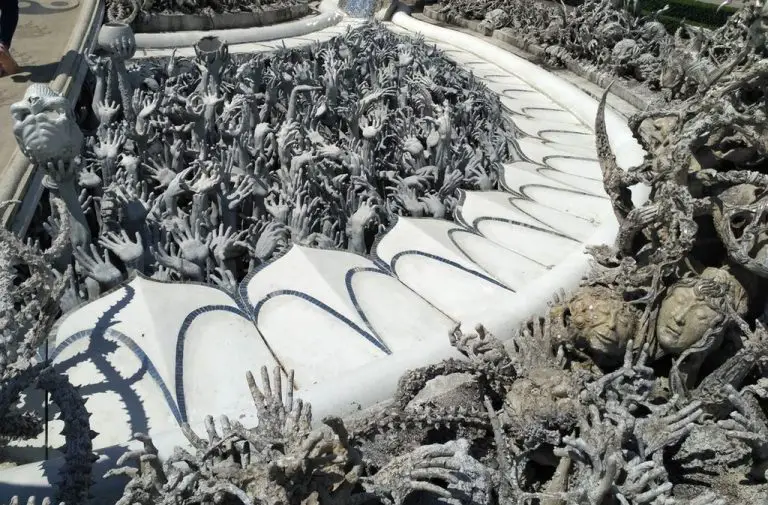
Golden Palace
The building with the intriguing name Golden Palace actually looks very impressive, thanks to intricate ornaments and decorations. The palace is ennobled with flower plantations from the outside. In fact, the building, it turns out, has a toilet purpose, so it is much less visited by tourists. Nevertheless, in order to get acquainted with the interiors of the palace, one has to change shoes and defend a real line – many tourists want to capture its decoration in the photo. But this moment should not confuse visitors – nearby toilets are provided.
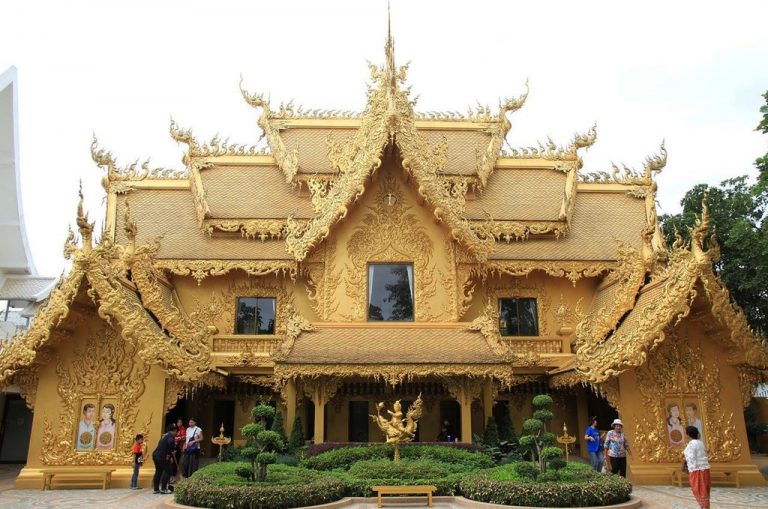
The grace of the green edging of the palace
The area surrounding Wat Rong Khun also did not go unnoticed by the architect. For walks and walks, beautiful paths are laid out, in the shade of the trees there are benches for relaxation, the platforms are decorated with vegetation. Everything was done for the convenience of travelers who decided to devote their time to studying the White Temple in Thailand.
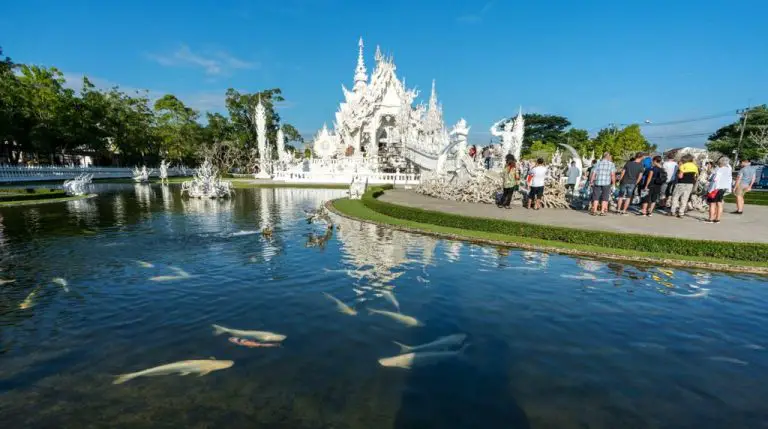
The green territory is also ennobled with the help of regular semantic sculptural compositions with the participation of Buddha and other traditional accompanying characters. The tree branches are decorated with unusual masks, and a fish pond is built near the temple in the park. By the way, the inhabitants of the reservoir are rather large specimens, numerous and very bright in color, it is interesting to observe their motley flocks and even more interesting to feed right from the hand.
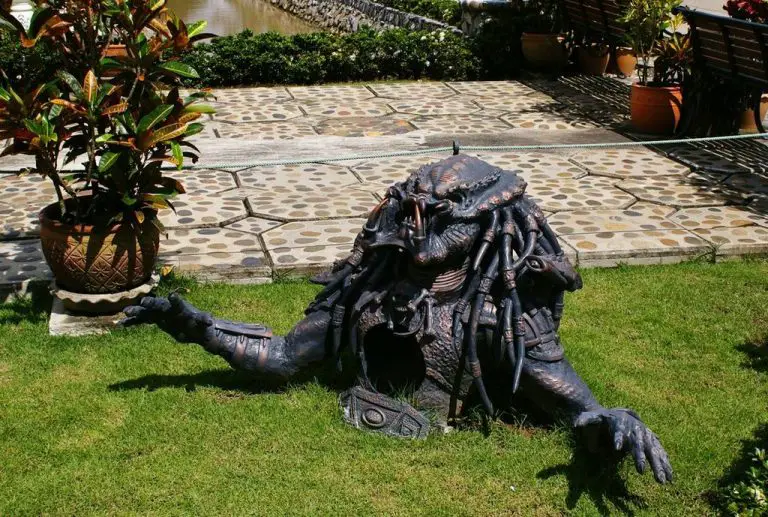
Another intricate attraction of the temple complex is the well, also nicknamed the golden one. A belief is associated with it: if you make a wish, throw a coin and hit the center of the well, it will come true. It is believed that the notes with prayers left on specially designated trees contribute to the embodiment of human aspirations. The White Temple of Wat Rong Khun is a true source of hope and comfort.
Unique temple interiors of Wat Rong Khun
No less interesting is the interior decoration of temple buildings. The interior of the White Temple of Thailand is half empty, which symbolizes purity from unnecessary thoughts. In the center is a figure of a monk that amazes visitors with its naturalness of execution and striking resemblance to a person. The walls are painted by the creator of the temple, the paintings are distinguished by the use of golden tones, and the scenes depicted continue the theme of the struggle between good and evil.
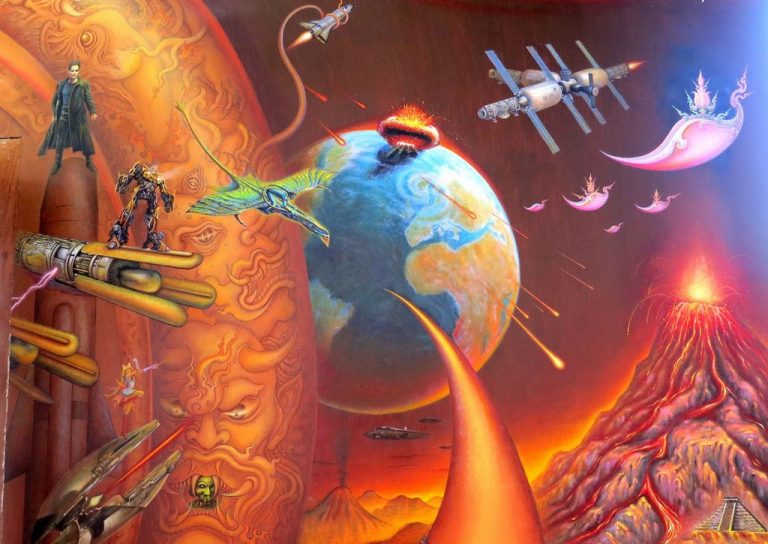
Currently, the murals are partially under restoration after the earthquake. One of the walls is reserved for a Buddhist altar with the corresponding elements.
Where is the white temple in Thailand and how to get there
The white temple is located near the Thai city of Chiang Rai in the northern region of Thailand, and it will not be difficult to solve the problem of how to get to Wat Rong Khun. About 13 km from Chiang Rai in the south is another city – Tiang Mai, from where minibuses or regular taxis will be brought to the White Temple. Finding it yourself on your car will also work out: where the White Temple in Thailand is located, residents of nearby settlements will be able to tell.
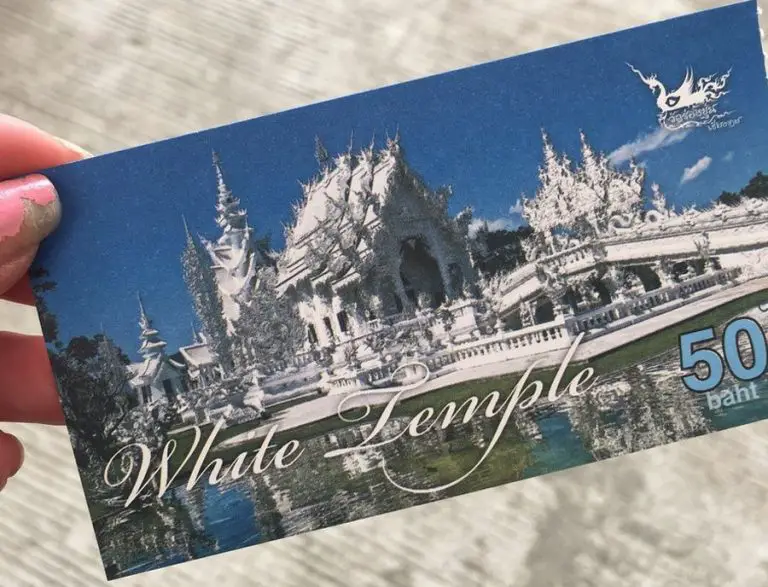
Address: Lahaul-Spiti | Pa O Don Chai Subdistrict, Chiang Rai 57000, Thailand.
The working hours of the temple: 7: 00-17: 00 from March to October, when the flow of visitors is not so great; 7 a.m. – 6 p.m. from November to February. External splendor can be admired all year round.
Cost of visit: 50 baht.
Interesting Facts
- Over the entire period of construction, the white temple of Wat Rong Khun has been visited by about 5 million tourists. And given that its location is far from traditional tourist routes, this is a substantial amount.
- The author, in an impulse to convey to the contemplator of his creations, the simplicity of the world, which has become the scene of an endless struggle between dark and light forces, has incorporated into his brainchild a number of new objects that are familiar to modern man. These are the heroes of cult science fiction films (The Matrix, Alien, Spider-Man, Star Wars and others), as well as events that shocked the world (September 11).
- The sculpture of a monk in the center of the White Temple is made so skillfully that many perceive it as a mummified real body. However, this is not so – the figure is made of wax materials.
- It is remarkable and at the same time symbolic that it is no longer possible to get back on the same bridge, because it is a transition to eternal happiness. So to leave the temple complex is taken in a different way.
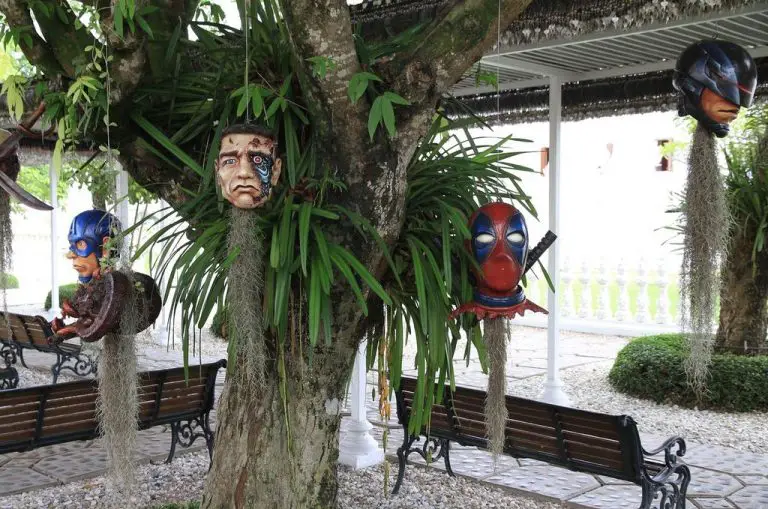
Useful Tips
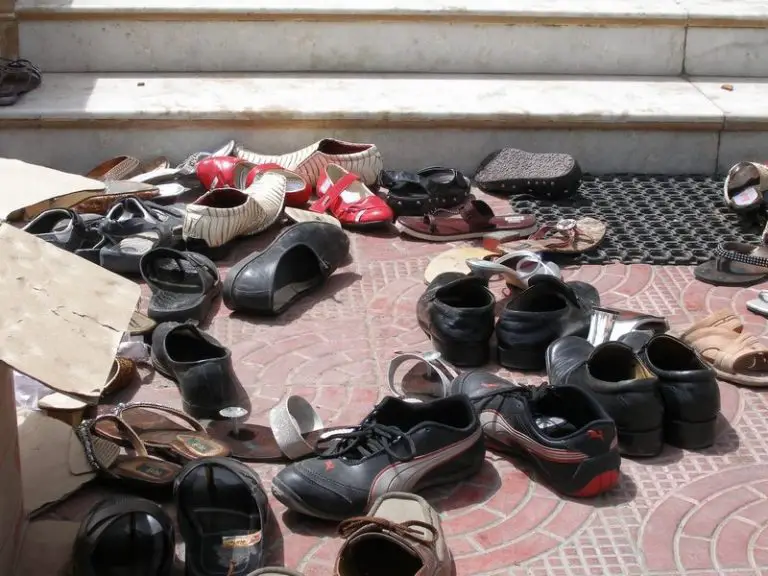
- When visiting the White Buddhist temple, it is required to leave shoes in front of the entrance. Let this not bother you, these are the usual everyday practices in the eastern and southeastern parts of Asia, including Thailand. The nature and purpose of the place is such that theft of shoes is simply impossible.
- When visiting the complex, be sure to purchase souvenirs or paintings by the artist – this will not only preserve the memory of a unique place, but also help further construction and development.
- Do not try to take a photo inside the White Temple – this is prohibited.
- It is imperative to comply with the clothing requirements common in religious Asian buildings – there should not be open areas (arms, legs).

Wat Rong Khun is a truly amazing place. Here, it was possible to successfully combine traditions and modernity, which undoubtedly contributes to the development of world perception among visitors and increases interest in the study of Buddhism and, in general, spiritual practices among representatives of the young generation.
What the famous temple looks like and a lot of useful information about the city of Chiang Rai can be found in this video.